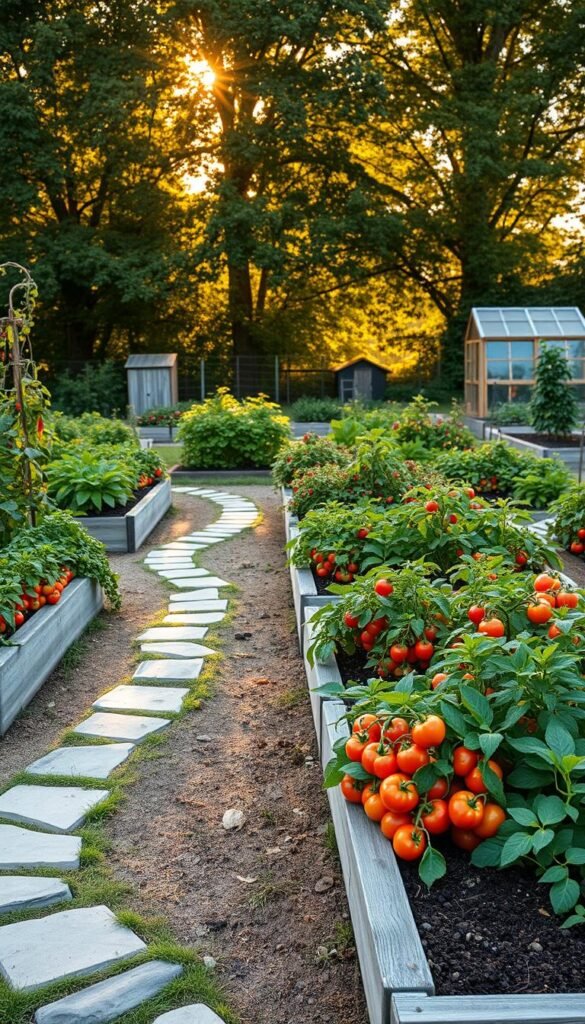There’s nothing quite like biting into a sun-warmed tomato you nurtured from seed or snipping fresh herbs steps from your kitchen. Growing your own food blends joy with practicality, turning even small spaces into sources of nourishment. With the right approach, you can enjoy crisp greens in spring, juicy peppers in summer, and hearty root veggies well into cooler months.
This guide simplifies how to build a productive, eco-friendly plot tailored to your lifestyle. You’ll learn to assess sunlight patterns, soil quality, and seasonal shifts to make the most of your area. Whether you’re working with raised beds, containers, or backyard rows, smart layouts ensure every inch counts.
Discover how pairing compatible species boosts growth naturally, reducing pests without chemicals. Timing is key—succession planting and crop rotation keep soil rich and harvests steady. We’ll share tips for choosing varieties that thrive in your region and align with meals you love.
Imagine stepping outside to gather ingredients for dinner, knowing exactly how they were grown. It’s not just about saving money—it’s about flavor, freshness, and connecting with nature’s rhythms. Let’s turn that vision into your reality.
Getting Started with Your Organic Veggie Garden
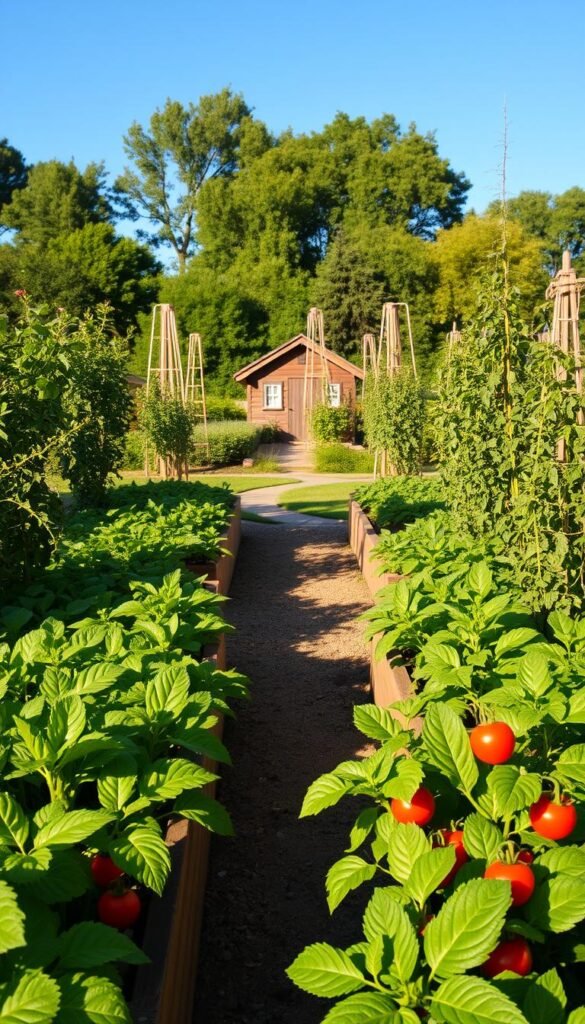
Think of your growing area as a blank canvas waiting for life. Before grabbing seeds or tools, pause to study your surroundings. Successful plots begin with observation—notice where sunlight lingers, where water pools, and what’s already thriving naturally.
Identifying Your Space and Resources
Start by mapping your available areas. Use a tape measure to note dimensions, then sketch rough boundaries. Pay attention to slopes, tree roots, or structures that cast shadows. Even a modest balcony or patio can host container plants if you maximize vertical space.
Test your soil’s texture and drainage by squeezing a handful—crumbly earth that holds shape briefly is ideal. If you’re tight on room, consider joining community urban gardens to access shared plots. These spaces often provide tools and expert advice too.
Begin with two or three raised beds or large pots. Focus on easy growers like leafy greens or bush beans. “Small successes build confidence,” says veteran grower Maria Sanchez. Track sunlight patterns over a week—most edibles need 6+ hours daily. This groundwork prevents overwhelm and helps your plants thrive from day one.
Understanding Year-Round Produce and Growing Seasons
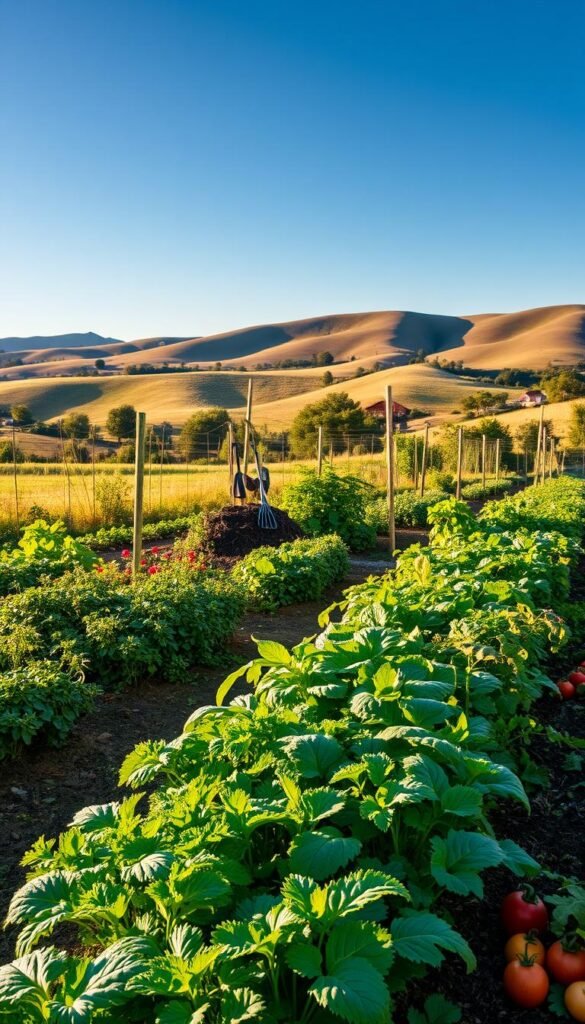
Ever wonder how some gardens burst with color and crunch through every season? It’s all about syncing with nature’s calendar. Your local growing season determines which plants thrive when—cool-weather favorites like spinach bolt in summer heat, while tomatoes shiver at frost’s first whisper.
Start by learning your area’s frost dates. These bookends define safe planting windows. Cool-season stars like kale and peas flourish in spring’s chill, then make room for summer staples like zucchini as soil warms. “Timing beats muscle every time,” notes urban farmer Luis Rivera. Stagger plantings every 2-3 weeks for nonstop harvests.
Use this seasonal rhythm to your advantage. In warmer zones, grow cold-hardy crops like carrots under row covers through winter. Track temperatures—many vegetables have narrow comfort zones. Leafy greens prefer 60°F days, while peppers demand 70°F+ nights.
Rotate crops annually to keep soil lively. Follow heavy feeders like corn with nitrogen-fixing beans. This dance of plants across seasons prevents depletion and pests. With smart sequencing, your plot becomes a perpetual pantry.
Site Selection: Maximizing Sunlight and Water Access
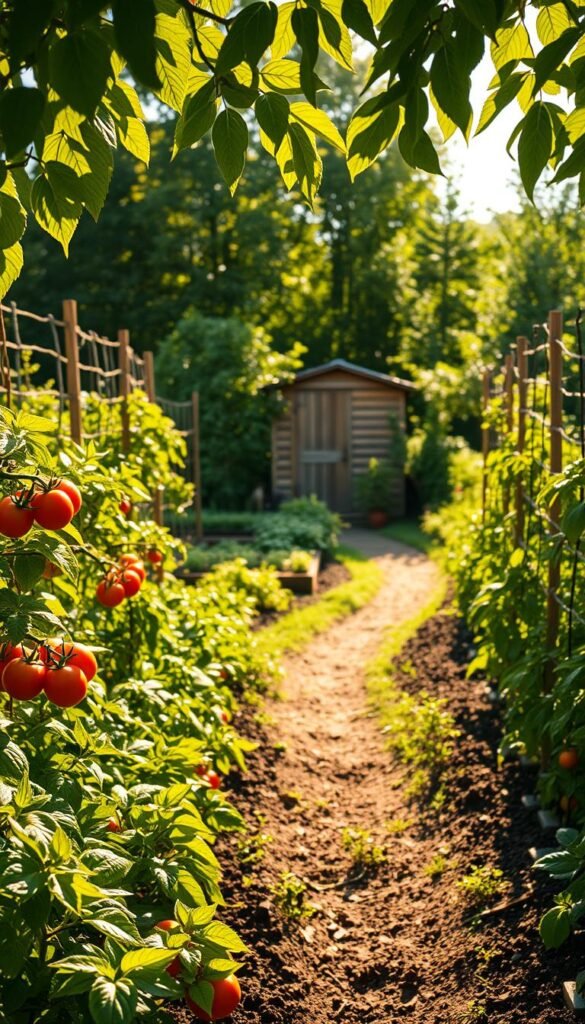
Sunlight and water are the lifeblood of any productive growing area. Your location choice directly impacts plant health and harvest size. Most crops need 6-8 hours of daily sun, while water access prevents drought stress. Let’s explore how to balance these essentials.
Assessing Sun Exposure and Shade
Track how light moves across your yard through seasons. South-facing spots get the strongest rays, while north areas stay shaded. Use free apps or a simple sun map—trace shadows hourly on graph paper. Structures like sheds or trees create shifting shade patterns.
Leafy greens tolerate 4-5 hours of sun, but tomatoes demand full exposure. Rotate containers to chase light if needed. “Watch how dawn hits your space—morning sun is gentler than afternoon blaze,” advises horticulturist Ellie Tran.
Locating a Water Source Nearby
Position beds within 10 feet of spigots or rain barrels. Drip irrigation systems save time and reduce waste. For small-space solutions, use self-watering pots or group containers near downspouts.
Test soil moisture daily—dry topsoil means it’s time to hydrate. Mulch beds to retain water between rains. Remember: consistent access beats marathon watering sessions. Your back will thank you!
Sketching Your Garden Layout on Paper
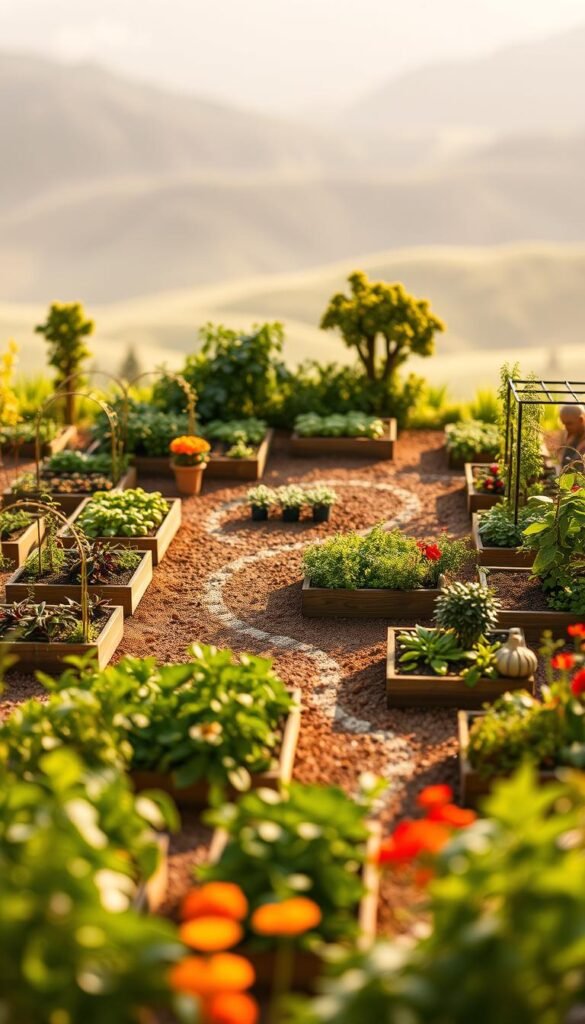
Putting pencil to paper transforms your gardening ideas into actionable plans. This step bridges imagination and reality, helping you spot potential issues before moving dirt. Grab graph paper—each square equals one foot—to maintain accurate proportions as you map your space.
Creating a Scaled Diagram for Raised Beds and Containers
Start by marking boundaries and permanent features. Draw garden beds no wider than 4 feet—this lets you reach the center without compacting soil. Leave 3-foot pathways between beds for wheelbarrows and kneeling space. “A good diagram accounts for both plants and people,” notes landscape designer Clara Myers.
Plot container placements near water sources if possible. Use colored pencils to differentiate crops—greens in cool tones, tomatoes in reds. This visual coding simplifies seasonal rotations. Test three garden layout variations to compare sunlight distribution and workflow efficiency.
Your sketch becomes a living document. Update it as plants mature or you add trellises. Keep the paper protected in a plastic sleeve near your tools. With this vegetable garden layout blueprint, you’ll plant with confidence knowing every squash vine and lettuce head has its perfect spot.
Listing Your Favorite Vegetables and Companion Plants
Your plate holds clues to your perfect garden lineup. Start by jotting down meals your family craves weekly—those vegetables that disappear fastest from your fridge become top candidates. This approach turns your plot into a personalized food hub rather than a generic produce section.
Curating a Personal Plant Wishlist
Rank your want to grow list by flavor and frequency of use. Cherry tomatoes might edge out bell peppers if you make daily salads. “Always plant what makes you smile when harvesting,” suggests urban gardener Diego Martinez. Leave space for one experimental pick—like purple carrots—to keep things exciting.
Vertical growers like cucumbers save ground space. Pair them with bush beans that enrich soil as they grow. For perennial plants, dedicate a corner to asparagus crowns that’ll feed you for 15+ years. Strawberries make great border plants, doubling as ground cover.
Research natural allies:
- Tomatoes thrive near basil (repels hornworms)
- Radishes protect squash from beetles
- Marigolds deter nematodes near root crops
Balance ambition with reality—if kale rarely lands on your table, skip it despite its “superfood” status. Focus on vegetables you’ll truly enjoy from seedling to skillet. This plant selection strategy ensures every square foot delivers delicious returns.
Utilizing Raised Beds and Container Gardening Options
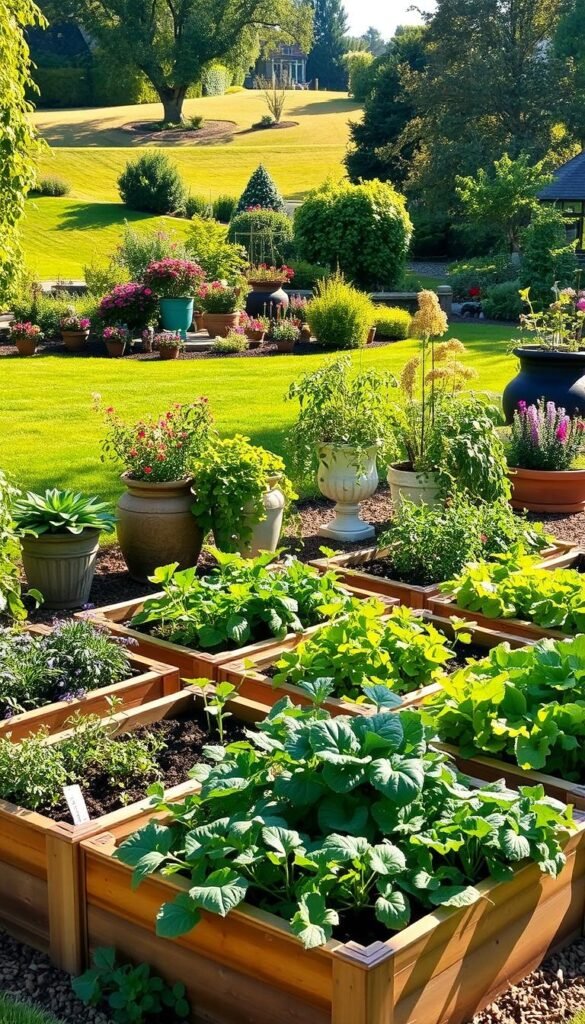
Elevate your growing game—literally. Raised beds let you craft ideal soil conditions while saving your back from constant bending. These elevated plots warm faster in spring, extending your growing season naturally. Containers bring fresh flavors to patios, balconies, and windowsills, proving you don’t need acres to harvest abundance.
Raised beds solve drainage nightmares in clay-heavy yards. Fill them with nutrient-rich soil blends tailored to your crops. Cedar or composite materials last 10+ years, while metal troughs add modern flair. Keep beds 3-4 feet wide for easy access from all sides.
Discover which vegetables thrive where:
| Feature | Raised Beds | Containers |
|---|---|---|
| Soil Control | Full customization | Mix per plant needs |
| Space Efficiency | High yield per square foot | Vertical stacking options |
| Mobility | Permanent placement | Move with sunlight |
Herbs and cherry tomatoes flourish in 5-gallon pots near sunny windows. For root crops, choose containers 12+ inches deep. “Start with three pots—basil, lettuce, and peppers. Success breeds ambition,” suggests container gardener Lila Chen.
Both systems simplify seasonal maintenance. Rotate crops easily between beds, and refresh container soil annually. As your confidence grows, add more modules—each becomes a fresh canvas for culinary experiments.
Optimizing Growing Space with Vertical Gardening
Look up—your garden’s next frontier might be overhead. Vertical gardening turns walls, fences, and airspace into lush growing space, letting you cultivate more plants without expanding your footprint. By training crops upward, you create room for leafy greens below while boosting airflow and sunlight exposure.
Trellis Ideas for Climbing Vegetables
Sturdy supports make all the difference for vining vegetables. Cattle panel arches handle heavy squash, while bamboo teepees suit lighter beans. “A trellis should be twice as strong as you think necessary,” advises grower Samira Patel. For small areas, attach expandable lattice panels to sunny walls or use repurposed ladders.
Try these setups:
- A-frame systems with shade-tolerant lettuce underneath
- Hanging gutter planters for strawberries or herbs
- Tension wires between posts for pea vines
Selecting Ideal Vining Plants
Some plants climb naturally, while others need guidance. Pole beans spiral upward instinctively, whereas cucumbers require weekly training. Malabar spinach thrives in heat, producing edible leaves all summer. Pair these climbers with compact basil or parsley below to maximize every space.
Top performers include:
- Scarlet runner beans (attract pollinators)
- Mini cucumber varieties like ‘Spacemaster’
- Tromboncino squash (saves ground space)
Rotate crops annually—follow heavy feeders like melons with nitrogen-fixing peas. This vertical strategy transforms narrow side yards or balconies into growing space that rivals traditional plots.
Integrating Beauty Into Your Organic Garden Design
Who says practical spaces can’t dazzle the eye? Your edible plot can burst with color while feeding your family. By blending tasty crops with eye-catching elements, you create a living masterpiece that nourishes both body and soul.
Swap straight rows for flowing curves. Wavy bed edges soften hardscapes and mimic nature’s patterns. “Curved lines invite exploration—they make visitors wonder what’s around the bend,” shares landscape artist Maya Cortez. Tuck vibrant nasturtiums between kale plants or let purple basil frame tomato vines for instant visual pop.
Flowers aren’t just pretty faces—they’re pest patrol and pollinator magnets. Try these pairings:
| Design Element | Beauty Boost | Practical Benefit |
|---|---|---|
| Sunflower hedges | Golden blooms | Shade for heat-sensitive greens |
| Lavender borders | Fragrant purple spikes | Deter deer and rabbits |
| Zinnia clusters | Rainbow petals | Attract bees and butterflies |
Play with textures and heights. Feathery carrot tops contrast with glossy pepper leaves. Red-stemmed chard adds drama beside silvery sage. Even practical trellises become art when draped with scarlet runner beans or moonflowers.
Upcycle colorful containers as focal points—a cobalt pot bursting with parsley anchors a corner. Garden design thrives on personal touches: mosaic stepping stones, whimsical scarecrows, or a repurposed ladder holding strawberry planters.
“Your space should make you pause and smile before you even reach for the harvest basket,” Cortez adds. With these ideas, your garden becomes a destination—not just a food source—where beauty and bounty grow hand in hand.
Creative Approaches for an Informal Garden Layout
Nature doesn’t grow in straight lines—why should your space? Ditch the ruler and let your plot flourish with wild charm. Informal garden layouts work with nature’s patterns, blending edibles and ornamentals into thriving communities.
This approach turns your plot into a living tapestry. Tall sunflowers become bean poles, while marigolds nestle between tomato vines. “Chaos has purpose here—it’s how ecosystems self-regulate,” explains permaculture designer Rosa Nguyen.
Blending Blooms and Bounty
Pairing flowers with vegetables isn’t just pretty—it’s strategic. Try these combinations:
| Companion Pair | Beauty Boost | Functional Benefit |
|---|---|---|
| Nasturtiums + Cabbage | Orange blooms | Deter aphids |
| Calendula + Carrots | Golden petals | Improve soil health |
| Borage + Squash | Star-shaped flowers | Attract pollinators |
Vining peas soften trellis lines while shading lettuce below. Herbs like thyme spill over bed edges, suppressing weeds. This layered layout creates microclimates—cool roots under leafy canopies, warm spots for peppers.
You’ll notice fewer pests as diversity confuses invaders. Soil stays moist longer under plant umbrellas. Best part? Your vegetable garden becomes a destination where beauty and dinner ingredients grow side by side.
Locating Your Garden Close to the Kitchen
Your daily meals hold the secret to perfect garden placement. When fresh ingredients grow just steps from your stove, you’ll snip herbs while simmering sauces and grab greens as pasta boils. This seamless connection turns cooking into a fluid dance between soil and skillet.
Gardens near back doors thrive because they become part of your routine. You’ll notice thirsty plants during morning coffee checks and spot aphids while taking out trash. “Out of sight means out of mind—and out of water,” warns urban farmer Jenna Wu. Closeness builds consistency, leading to healthier crops.
Try these space-smart strategies:
- Frame walkways with edible flowers like calendula
- Swap foundation shrubs for blueberry bushes
- Use window boxes for compact herbs
Front yards work too! Blend veggies with ornamentals:
| Location | Edible Star | Ornamental Partner |
|---|---|---|
| Entry Path | Rainbow chard | Dwarf boxwood |
| Mailbox Base | Bush beans | Marigolds |
Keep tools and compost within arm’s reach. A small bin under the sink collects scraps, while a weatherproof cabinet stores gloves and pruners. When everything lives nearby, maintenance becomes quick pit stops rather than weekend marathons.
This setup isn’t just practical—it’s inspiring. You’ll toss extra basil into smoothies and top pizzas with just-picked peppers because harvesting feels effortless. Your vegetable garden transforms from distant project to kitchen companion, nourishing both meals and momentum.
Planting Densely for Maximum Yield
Imagine plucking a handful of carrots while basil brushes your elbow—this is the magic of smart spacing. Packing plants like puzzle pieces lets you harvest more from every square foot while creating natural pest barriers. The trick lies in balancing proximity with airflow to prevent overcrowding.
Strategies to Manage Plant Spacing Effectively
Start with vertical layers. Grow tall crops like pole beans on trellises, then tuck shade-tolerant spinach beneath them. Stagger planting dates for fast-growing radishes between slower cabbage plants—you’ll harvest roots before leaves need the room.
Use borders wisely. Edge beds with compact herbs or flowers that deter pests without hogging space. “Pair deep-rooted tomatoes with shallow lettuce—they’ll drink from different soil levels,” suggests grower Micah Reyes. Square foot templates help visualize layouts, but stay flexible as plants mature.
Check leaves weekly—if they overlap heavily, thin seedlings or redirect vines. Dense doesn’t mean chaotic. With thoughtful arrangement, your plot becomes a lush tapestry where every leaf and stem earns its keep.

